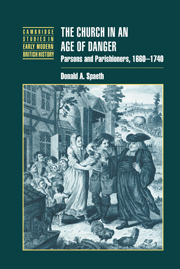Book contents
- Frontmatter
- Contents
- List of tables
- Acknowledgements
- List of abbreviations
- 1 Introduction
- 2 Clerical profiles
- 3 Arenas for conflict
- 4 The management of disputes
- 5 Pastoral care
- 6 Tithes and religious conflict
- 7 The nonconformist threat
- 8 Popular observance
- 9 Matters of life and death
- 10 Singing and religious revival
- 11 Conclusion
- Selected bibliography
- Index
- Cambridge Studies in Early Modern British History
5 - Pastoral care
Published online by Cambridge University Press: 28 July 2009
- Frontmatter
- Contents
- List of tables
- Acknowledgements
- List of abbreviations
- 1 Introduction
- 2 Clerical profiles
- 3 Arenas for conflict
- 4 The management of disputes
- 5 Pastoral care
- 6 Tithes and religious conflict
- 7 The nonconformist threat
- 8 Popular observance
- 9 Matters of life and death
- 10 Singing and religious revival
- 11 Conclusion
- Selected bibliography
- Index
- Cambridge Studies in Early Modern British History
Summary
Contemporaries and modern commentators alike have had few good words to say about the quality of pastoral care provided by the clergy in the eighteenth century. Clergymen were at best thought to be more devoted to hunting than to their spiritual duties, and at worst were regarded as covetous and lazy. Bishop Gilbert Burnet made himself few friends within the Church by publishing his view that the general neglect of pastoral care was one reason for the contempt in which the clergy were held. ‘It is not easy to bring the clergy to desire to take pains among their people,’ he complained; ‘they seem to have no great sense of devotion, and none at all of the pastoral care.’ The importance which Burnet placed upon pastoral care can be seen in his statement that his Discourse of the Pastoral Care, published in 1692, was the book he had written that pleased him the most. When the new bishop arrived in his Salisbury diocese he sought to put his principles into practice. Before his primary visitation he wrote to his clergy with instructions about their duties in their parishes and at visitations, which he followed up at subsequent visitations. In addition to discouraging pluralism, he encouraged clergymen to make frequent visits to houses in their parish and placed particular emphasis upon careful catechism, supported by instructional discourses.
- Type
- Chapter
- Information
- The Church in an Age of DangerParsons and Parishioners, 1660–1740, pp. 108 - 132Publisher: Cambridge University PressPrint publication year: 2000

